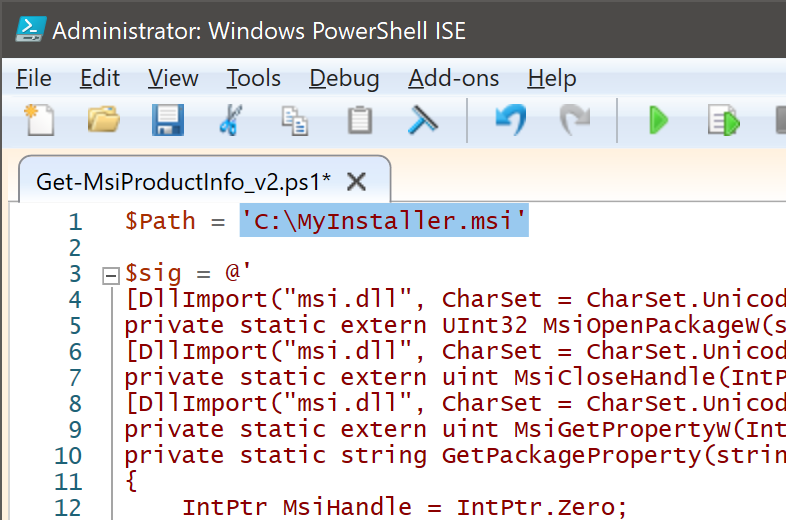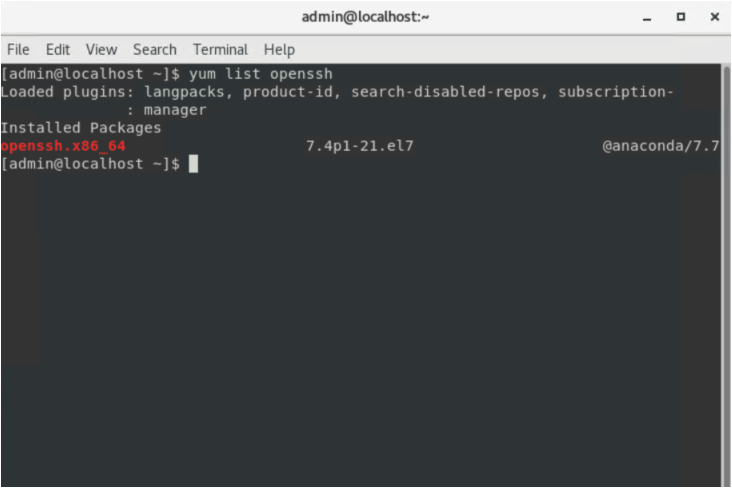RPS Patch Product Types
Last updated on June 21, 2021.
Last Reviewed and Approved on PENDING REVIEW
Introduction
This document provides guidance on how to get the values for Product ID, Product Name, and Product Version given the chosen Product Type.
Product Type is the type of product contained within a patch. The value chosen for Product Type will be used by RPS to determine how to deploy the product from the patch.
The Product Type must be accurate and match exactly with the product that will be deployed, otherwise deployment may not work as expected.
Certain fields are required to be filled in accurately depending on the chosen Product Type. This document describes which fields are required and how to obtain their values.
Product Types
Product Type: WindowsExe
The WindowsExe Product Type requires: Product ID, Product Name, and Product Version.
WindowsExe: Product ID
Product ID is required for WindowsExe.
To find the Product ID you need to install the product and look in the Windows Registry in the path:
HKLM:\SOFTWARE\Microsoft\Windows\CurrentVersion\Uninstall (You can use the "Find" command by right-clicking on the folder).
The Product ID will be either the normal text name of the product or the key of the product,
for example: {02A9F3AF-DB1E-30D4-B456-7B8BBB7BE2D3}.
You can also use the Get-WmiObject command to get the Product ID, Product Name, and Product Version from an installed EXE.
Get-WmiObject Win32_Product | Format-Table IdentifyingNumber, Name, Version
Note
In the above command, IdentifyingNumber is equal to Product ID in REACTR.
WindowsExe: Product Name
Product Name is required for WindowsExe.
To find the Product Name you need to install the product and look in the Windows Registry in the path:
HKLM:\SOFTWARE\Microsoft\Windows\CurrentVersion\Uninstall.
The Product Name will be the value of the Display Name for the product,
for example: Microsoft ASP.NET Core 3.1.7 Shared Framework (x64).
You can also use the Get-WmiObject command to get the Product ID, Product Name, and Product Version from an installed EXE.
Get-WmiObject Win32_Product | Format-Table IdentifyingNumber, Name, Version
Note
In the above command, IdentifyingNumber is equal to Product ID in REACTR.
WindowsExe: Product Version
Product Version is required for WindowsExe.
To find the Product Version you need to install the product and look in the Windows Registry in the path:
HKLM:\SOFTWARE\Microsoft\Windows\CurrentVersion\Uninstall.
The Product Version will be the value of the Display Version, for example: 3.1.7.0.
You can also use the Get-WmiObject command to get the Product ID, Product Name, and Product Version from an installed EXE.
Get-WmiObject Win32_Product | Format-Table IdentifyingNumber, Name, Version
Note
In the above command, IdentifyingNumber is equal to Product ID in REACTR.
Product Type: WindowsMsi
The WindowsMsi Product Type requires: Product ID, Product Name, and Product Version.
WindowsMsi: Product ID
Product ID is required for WindowsMsi. There are two ways to find the Product ID of a Windows MSI.
Install the product and look in the Windows Registry in the path:
HKLM:\SOFTWARE\Microsoft\Windows\CurrentVersion\Uninstall. The Product ID will be the key of the product, for example:{02A9F3AF-DB1E-30D4-B456-7B8BBB7BE2D3}.Use a tool to get information directly from the MSI.
Get-MsiProductInfo - Use this PowerShell script to get the Product ID, Product Name, and Product Version:
- Open PowerShell ISE As an Administrator
- Open Get-MsiProductInfo_v2.ps1 script.
Replace the value of the $Path variable with the path to your MSI installer.

Note
Make sure to save your changes to the script
Run the by clicking on the Run button or by pressing the 'F5' key.
Orca.exe - Use this Windows Installer SDK tool to get the Product ID, Product Name, and Product Version: https://docs.microsoft.com/en-us/windows/win32/msi/orca-exe
Get-WmiObject - Use this command to get the Product ID, Product Name, and Product Version:
Get-WmiObject Win32_Product | Format-Table IdentifyingNumber, Name, VersionNote
In the above command, IdentifyingNumber is equal to Product ID in REACTR.
WindowsMsi: Product Name
Product Name is required for WindowsMsi. There are two ways to find the Product Name of a Windows MSI.
Install the product and look in the Windows Registry in the path:
HKLM:\SOFTWARE\Microsoft\Windows\CurrentVersion\Uninstall. The Product Name will be the value of the Display Name for the product, for example:Microsoft ASP.NET Core 3.1.7 Shared Framework (x64).Use a tool to get information directly from the MSI.
Get-MsiProductInfo - Use this PowerShell script to get the Product ID, Product Name, and Product Version:
- Open PowerShell ISE As an Administrator
- Open Get-MsiProductInfo_v2.ps1 script.
Replace the value of the $Path variable with the path to your MSI installer.

Note
Make sure to save your changes to the script
Run the by clicking on the Run button or by pressing the 'F5' key.
Orca.exe - Use this Windows Installer SDK tool to get the Product ID, Product Name, and Product Version: https://docs.microsoft.com/en-us/windows/win32/msi/orca-exe
Get-WmiObject - Use this command to get the Product ID, Product Name, and Product Version:
Get-WmiObject Win32_Product | Format-Table IdentifyingNumber, Name, VersionNote
In the above command, IdentifyingNumber is equal to Product ID in REACTR.
WindowsMsi: Product Version
Product Version is required for WindowsMsi. There are two ways to find the Product Version of a Windows MSI.
Install the product and look in the Windows Registry in the path:
HKLM:\SOFTWARE\Microsoft\Windows\CurrentVersion\Uninstall. The Product Version will be the value of the Display Version, for example:3.1.7.0.Use a tool to get information directly from the MSI.
Get-MsiProductInfo - Use this PowerShell script to get the Product ID, Product Name, and Product Version:
- Open PowerShell ISE As an Administrator
- Open Get-MsiProductInfo_v2.ps1 script.
Replace the value of the $Path variable with the path to your MSI installer.

Note
Make sure to save your changes to the script
Run the by clicking on the Run button or by pressing the 'F5' key.
Orca.exe - Use this Windows Installer SDK tool to get the Product ID, Product Name, and Product Version: https://docs.microsoft.com/en-us/windows/win32/msi/orca-exe
Get-WmiObject - Use this command to get the Product ID, Product Name, and Product Version:
Get-WmiObject Win32_Product | Format-Table IdentifyingNumber, Name, VersionNote
In the above command, IdentifyingNumber is equal to Product ID in REACTR.
Product Type: WindowsHotfix
Note
WindowsHotfix displays as WindowsMsu in the Patch Product Type list when creating and editing a patch.
The WindowsHotfix Product Type requires: Product ID.
WindowsHotfix: Product ID
Product ID is required for WindowsHotfix.
To find the Product ID you can either look in the Microsoft Update Catalog or use the Get-Hotfix command.
The Product ID of a Hotfix is the KB number of the product, for example: KB3185911.
Get-Hotfix
Product Type: WindowsMsp
Note
The WindowsMsp Product Type is only available when creating an RPS Patch for Manifest Schema Version 2.0, which is compatible with RPS 4.0.
To install a WindowsMSP on RPS 3.1 you may use the Script Framework by following this example: Installing MSP Using the RPS Patching Script Framework.
The WindowsMsp Product Type requires: Product ID, Product Name, and Product Version.
WindowsMsp: Product ID
Product ID is required for WindowsMsp. There are two ways to find the Product ID of a Windows MSP.
Install the product and look in the Windows Registry in the path:
HKLM:\SOFTWARE\Microsoft\Windows\CurrentVersion\Uninstall. The Product ID will be the key of the product, for example:{02A9F3AF-DB1E-30D4-B456-7B8BBB7BE2D3}.Use a tool to get information directly from the MSP.
Orca.exe - Use this Windows Installer SDK tool to get the Product ID, Product Name, and Product Version: https://docs.microsoft.com/en-us/windows/win32/msi/orca-exe
Get-WmiObject - Use this command to get the Product ID, Product Name, and Product Version:
Get-WmiObject Win32_Product | Format-Table IdentifyingNumber, Name, VersionNote
In the above command, IdentifyingNumber is equal to Product ID in REACTR.
WindowsMsp: Product Name
Product Name is required for WindowsMsp. There are two ways to find the Product Name of a Windows MSP.
Install the product and look in the Windows Registry in the path:
HKLM:\SOFTWARE\Microsoft\Windows\CurrentVersion\Uninstall. The Product Name will be the value of the Display Name for the product, for example:Microsoft ASP.NET Core 3.1.7 Shared Framework (x64).Use a tool to get information directly from the MSP.
Orca.exe - Use this Windows Installer SDK tool to get the Product ID, Product Name, and Product Version: https://docs.microsoft.com/en-us/windows/win32/msi/orca-exe
Get-WmiObject - Use this command to get the Product ID, Product Name, and Product Version:
Get-WmiObject Win32_Product | Format-Table IdentifyingNumber, Name, VersionNote
In the above command, IdentifyingNumber is equal to Product ID in REACTR.
WindowsMsp: Product Version
Product Version is required for WindowsMsp. There are two ways to find the Product Version of a Windows MSP.
Install the product and look in the Windows Registry in the path:
HKLM:\SOFTWARE\Microsoft\Windows\CurrentVersion\Uninstall. The Product Version will be the value of the Display Version, for example:3.1.7.0.Use a tool to get information directly from the MSP.
Orca.exe - Use this Windows Installer SDK tool to get the Product ID, Product Name, and Product Version: https://docs.microsoft.com/en-us/windows/win32/msi/orca-exe
Get-WmiObject - Use this command to get the Product ID, Product Name, and Product Version:
Get-WmiObject Win32_Product | Format-Table IdentifyingNumber, Name, VersionNote
In the above command, IdentifyingNumber is equal to Product ID in REACTR.
Product Type: WindowsCabinet
Note
RPS Patches using the WindowsCabinet Product Type are only compatible with Windows KB (Knowledge Base) updates that have the CAB file format. Other CAB files may not work using the WindowsCabinet product type.
You can test if a CAB file is compatible with the WindowsCabinet Product Type by using the dism command described in the
RPS Patch Provider article.
If they are not compatible, then they may be able to be installed using the Script Framework Product Type and a custom PowerShell script that can install the file. For more information, see the RPS Patching Script Framework article.
Note
WindowsCabinet displays as WindowsCab in the Patch Product Type list when creating and editing a patch.
The WindowsCabinet Product Type requires: Product ID.
WindowsCabinet: Product ID
Product ID is required for WindowsCabinet.
To find the Product ID you can either look in the Microsoft Update Catalog or use the Get-Hotfix command.
The Product ID of a Windows Cabinet is the KB number of the product, for example: KB3185911.
Get-Hotfix
Product Type: LinuxRpm
The LinuxRpm Product Type requires: Product Name.
LinuxRpm: Product Name
Product Name is required for LinuxRpm.
To find the Product Name you can use the command line yum utility.
For example, to search for a patch called "openssh" you would use the command: yum list openssh .
From the yum search results, the Product Name is the name of the full yum patch name on the left-most side of the search results. (e.g. openssh.i386)

Product Type: Script Framework
The Script Framework Product Type does not require any specific Product-related fields (Product ID, Product Name, Product Version).